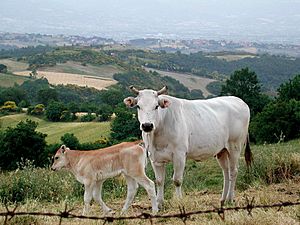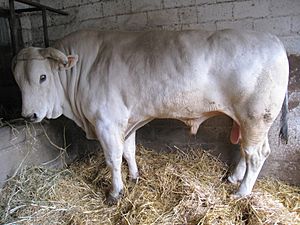Chianina facts for kids

A Chianina cow and calf in Tuscany
|
|
| Conservation status | FAO (2007): not at risk |
|---|---|
| Other names |
|
| Country of origin | Italy |
| Distribution | world-wide |
| Standard | ANABIC |
| Use | dual-purpose, draught and beef |
| Traits | |
| Weight |
|
| Height |
|
| Skin color | black |
| Coat | white hair, black switch |
| Horn status | horned |
|
|
The Chianina is a special type of cattle from Italy. For a long time, these animals were used to pull things, like plows in fields. Today, they are mostly raised for their meat. The Chianina is known for being the biggest and one of the oldest cattle breeds in the world. Its meat is used to make the famous bistecca alla fiorentina, a delicious steak from Florence.
Contents
History of the Chianina
The Chianina breed comes from an area in Italy called the Valdichiana. This is where it gets its name. People have been raising these cattle in parts of Tuscany, Umbria, and Lazio for over 2,200 years. Ancient Roman writers even mentioned large, white cattle from this region.
For a long time, Chianina oxen were the main source of power for farming in Italy. They pulled farm equipment and helped with transport. After the Second World War, machines started to do this work instead. Even so, some Chianina oxen are still used in special events today. One example is the corteo storico parade at the Palio di Siena, a famous horse race.
Since the 1930s, farmers started to breed Chianina cattle more for meat. They looked for animals with shorter legs and more muscle. Today, they also focus on how fast the cattle grow and the quality of their meat. After the Second World War, Chianina cattle became popular around the world. They were sent to countries like China, Russia, and the Americas. People everywhere wanted their high-quality meat.
What Chianina Cattle Look Like
The Chianina is the tallest and heaviest cattle breed. Adult bulls can stand as tall as 1.8 meters (about 6 feet). Some oxen can even reach 2 meters (about 6.5 feet) tall. It's common for bulls to weigh more than 1,600 kilograms (about 3,500 pounds).
A Chianina bull named Donetto holds the world record for being the heaviest bull. He weighed about 1,780 kilograms (almost 4,000 pounds) and was 1.85 meters (over 6 feet) tall. Female Chianina cows usually weigh between 800 and 900 kilograms (about 1,700 to 2,000 pounds). Some can weigh over 1,000 kilograms (2,200 pounds). Even newborn calves are quite large, often weighing over 50 kilograms (110 pounds).
Chianina cattle have a beautiful white coat. Sometimes, they have a very light grey shade around their eyes. Their skin, nose, tail switch, and hooves are all black. Their eyelids, mouth, and tongue are also black.
How Chianina Cattle Are Used
The Chianina is a "dual-purpose" breed. This means they are used for two main things: pulling work (draught) and producing meat. They don't produce much milk, just enough for their calves.
Draught Use
In the past, Chianina oxen were very important for farming and transport in Italy. They were strong and could work well on hilly land. They were often used in pairs, pulling carts or plows. Many old farmhouses in Italy even had special stables for these oxen on the ground floor.
Today, you won't see many Chianina oxen working on farms in Italy. Machines have taken their place. However, they are still part of special events, like the Palio di Siena parade. In North America, some Chianina oxen are trained for pulling contests. They can pull very heavy loads.
Meat Production
Chianina cattle are excellent for meat production. They grow very quickly, sometimes gaining over 2 kilograms (4.4 pounds) per day. Their meat is known for being high quality and very tasty. It also has good nutritional value.
Farmers usually slaughter Chianina cattle when they are 16 to 18 months old. At this age, they weigh about 650 to 700 kilograms (1,400 to 1,500 pounds). The meat yield (how much usable meat you get) is very high. In Italy, Chianina meat is sold at special butcher shops. The sales receipt often shows details about the animal to prove it's real Chianina meat. This helps guarantee its origin and quality.
Cross-breeding
Chianina cattle are also often used to cross-breed with other types of cattle. In the United States, they are mixed with British breeds. This helps to make the meat less fatty, which is popular today. In other places, Chianina are cross-bred to make local cattle bigger and grow faster.
They pass on good qualities like fast growth, good meat quality, and being tough against heat, cold, insects, and diseases. Cattle that are cross-bred with Chianina can reach their full size about a month earlier than usual. This makes them very valuable for farmers around the world.


